Physical Address
304 North Cardinal St.
Dorchester Center, MA 02124
The digestive system is an integrated collection of anatomically and physiologically distinct organs and structures. They may be involved in a large number of important inflammatory and neoplastic diseases, most of which have been well characterized histologically. Yet, the key cytologic features of many of these entities are less widely recognized, despite the fact that the majority of clinically significant disorders originate in, or are concentrated within, the mucosa. The use of fiberoptic endoscopy allows relatively easy and safe access to the mucosa, allowing for both histologic and cytologic biopsies. Even submucosal diseases, such as stromal tumors, can be reached by needle biopsy accurately with the aid of endoscopic ultrasound.
Exfoliative and aspiration cytology enjoys several theoretical advantages over tissue biopsies. One of the more important of these is that the endoscopic brush may retrieve epithelial cells from a much larger surface area of the mucosa. Even when a large number of biopsies are obtained, sampling by the brush is intrinsically more thorough and extensive. Most submucosal lesions cannot be sampled well by biopsy forceps, whereas they are quite accessible by aspiration biopsy. Another advantage is in the evaluation of stenotic lesions, as the brush has much greater accessibility to the neoplasm than do biopsy forceps, which is especially true in the region of the gastroesophageal junction. As discussed in this chapter, recent work has demonstrated the utility of exfoliative cytology of the gastrointestinal mucosa as an adjunct to tissue biopsy. The two together are capable of greater sensitivity and earlier detection of malignancy than either alone. Cytologic biopsies also incur a much lower cost in time and money than histologic biopsies. This is especially important in surveillance programs, in which numerous endoscopic biopsies may be procured. Also, in some laboratories, cytology has a more rapid turnaround time than the concurrently obtained biopsy specimens. This is clearly the case with on-site evaluation of submucosal aspirates.
Despite these advantages, cytology is currently underutilized in patients with gastrointestinal (GI) or hepatobiliary disease. Overall, GI cytology is still extremely useful in the detection of some infections and pre-malignant and malignant lesions. A common theme presented throughout this chapter is the complementary value of cytology and histology in providing an increased diagnostic yield.
Esophageal cytology is not commonly utilized in the USA, as an endoscopy with tissue biopsy is much more popular as a diagnostic modality. In addition to conventional brushings, cytologic samples can be obtained by blindly lowering an uninflated balloon to the gastroesophageal junction, or as near to this junction as can be reached blindly. Texture is added to the surface of the balloon, to better entice the epithelial cells to the specimen container. The balloon is inflated, and the entire apparatus is then removed, abrading the squamous lining of the esophagus. Though enticing in theory, the sensitivity for early detection of squamous cell carcinoma has been rather disappointing. Early data, however, give reason for optimism with regard to cytologic techniques in early detection of Barrett's esophagus and esophageal adenocarcinoma with endoscopically directed esophageal brushes.
Almost the entire length of the esophagus is lined by a non-keratinizing stratified squamous epithelium. The distal most 1–2 cm may be lined by a simple columnar cell epithelium with or without mucus production. Immediately beneath the epithelium is the lamina propria, which consists of loose connective tissue. Throughout the entire length of the esophagus, the lamina propria contains glandular structures that histologically resemble those present in the cardiac portion of the stomach; these secrete predominantly neutral mucins. The submucosa of the esophagus contains glandular structures that empty their secretions into the esophageal lumen via ducts lined by stratified squamous epithelium; acidic mucins predominate. Goblet cells are not normally present in the esophagus or stomach.
Accordingly, cytologic specimens from the esophagus are dominated by squamous epithelial cells of the superficial and intermediate types. The former are characterized by abundant delicate eosinophilic cytoplasm, polygonal contours, and a solitary centrally positioned pyknotic nucleus. Very infrequent cells may also possess keratohyalin granules. According to Shen and coworkers, the vast majority of the cells have an intermediate level of maturation ( Fig. 14-1 ). Their nuclei are thus larger and have finely granular chromatin and possibly small chromocenters. Generally, nucleoli are not evident. Both types of squamous cells are present in large flat sheets, in small clusters, in concentric arrangements (“pearls”), and as solitary cells. Rarely, smears may also contain parabasal cells, presumably the result of very vigorous sampling. These typically appear as single cells with round or ovoid contours, with dense cyanophilic cytoplasm and relatively high nuclear to cytoplasmic (N : C) ratios.
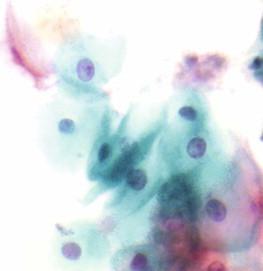
Glandular elements may also be present in normal esophageal brushings, the consequence of either inadvertent sampling of the stomach and/or procurement of columnar cells that may normally be present in the distal-most esophagus. These cells are present in small to large, generally flat sheets with sharply defined edges, distinct cellular borders, and small round nuclei with finely granular, pale-staining chromatin, and inconspicuous nucleoli. Their cytoplasm is delicate and finely granular; large vacuoles are not evident.
Several contaminants may be seen in otherwise totally unremarkable smears. These include ciliated respiratory columnar cells, pigment-containing alveolar macrophages, meat fibers, plant cells, and microbes from the oral cavity.
A patient presenting with odynophagia often raises clinical suspicion of infectious esophagitis. This symptom is an important clinical hallmark of infectious esophagitis because it is not commonly seen in the more frequent gastroesophageal reflux disease. Other commonly associated symptoms include dysphagia, chest pain, and upper gastrointestinal hemorrhage. Such clinical findings can lead to an endoscopy. Abnormal mucosa seen on endoscopy can then prompt a histologic or cytologic sampling, which can assist in microscopic detection of the offending infectious agent. On our literature search, there is very little written about the sensitivity and specificity of cytology alone in the diagnosis of infectious esophagitides. The “gold standard” is often thought to be histologic biopsy with immunohistochemistry. What little has been published on the competition between cytology and histology in infectious esophagitides does not strongly favor cytology over biopsy; in fact, quite the opposite. There is some suggestion that movement be made towards a polymerase chain reaction (PCR)-based diagnosis in these diseases.
Though Candida spp. are among the most common etiologic agents of infectious esophagitides, the commonality does not imply banality. In elderly patients, for example, Candida esophagitis is associated with a poor outcome, regardless of the prognosis of any other concurrent disease process. The elderly, of course, are not the only patient group at risk for Candida esophagitis. A smattering of other risk factors have been identified, including hypochloridia due to vagotomy or the use of proton pump inhibitors, and inhaled corticosteroids. Immune suppression is a very commonly associated condition leading to Candida esophagitis, but it is not the most common cause of this condition in many studies exploring risk factors.
Endoscopic findings are characteristic, with patches of yellow material adherent to the esophageal mucosa with surrounding mucosal erythema. On biopsy, Candida species often demonstrate non-branching pseudohyphae, which can grow up to 2 µm in diameter. Pseudohyphae are not true hyphae because true septations are not seen in Candida species. Instead, pseudohyphae can have periodic indentations along the long axis of the organism that mimic true septations. The pseudohyphae can be admixed with yeast forms (up to 4 µm in diameter), imparting a “spaghetti and meatballs” morphology ( Fig. 14-2 ). Without the yeast, the pseudohyphae have been likened to “links of sausage.”
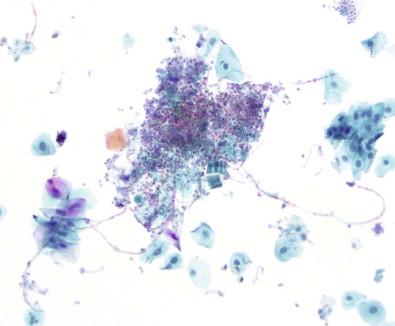
Pathologic diagnosis of esophagitis from Candida infections can be the made with both cytologic brushings and with tissue biopsy. There are some older, limited data to indicate that there is advantage to cytologic brushing over tissue biopsy in the diagnosis of Candida , most likely because Candida typically is concentrated at or near the mucosal surface and thus is readily accessible to sampling by the brush, making brushings more sensitive for detecting Candida esophagitis than endoscopically directed tissue biopsy.
Pseudohyphae and/or budding yeast, in a background of acute inflammation and repair.
The esophagus is the portion of the alimentary canal that most commonly falls victim to infection by herpes simplex virus (HSV). It is an infectious disease that can strike both immunocompetent and immunosuppressed patients, though it tends to be an indolent, self-limited disease in the former. In the latter, it can lead to much more disabling symptoms than in patients with an intact immune system. As with the other esophagitides, odynophagia may prompt esophagoscopy, which typically demonstrates characteristic ulcers with a “punched out” appearance. Biopsy, either for histologic or for cytologic examination, with viral culture and molecular testing, may be performed.
Cytologically, herpes viral cytopathic effects are very characteristic. The infected squamous cells are enlarged with ground- glass nuclear inclusions that fill the nucleus and force the chromatin into a thin rim against the nuclear membrane ( Fig. 14-3 ). There may be multiple nuclei within the affected cells. In such cells, the nuclei often mold against each other. Less often, Cowdry type A inclusions may also be seen ( Fig. 14-3 inset). These are dark intranuclear inclusions that are surrounded by a halo of ground-glass material. Importantly, there are no distinct chromatin granules between the thickened nuclear membrane and the inclusion body; this is in contrast to the space in the membrane and nucleoli in malignant nuclei.
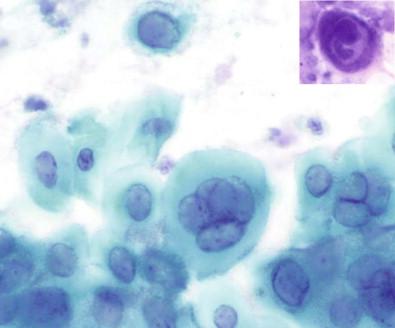
Ancillary studies, such as viral culture and real-time PCR (rt-PCR), can be used to aid in detection of HSV. Viral culture is not a very sensitive technique, compared with either biopsy or rt-PCR. rt-PCR is far more sensitive than culture, although studies comparing PCR to the gold standard of biopsy find that the negative predictive value of PCR is rather low. However, this may simply indicate that PCR is more sensitive than tissue biopsy in detecting HSV. A similar difficulty was faced in the early days of cardiac-specific troponins. Troponins produced a notable number of false negatives when compared with the traditional CK-MB fraction detection. The “false negatives” were actually positive tests that were missed by the less sensitive older analyte. This may also be the case with PCR as opposed to biopsy. More work is required to demonstrate this convincingly in HSV infections.
Squamous cells with increased cytoplasmic and nuclear volumes
Intranuclear inclusion bodies surrounded by a halo and thickened nuclear membrane
Ground-glass chromatin
Multinucleation, nuclear molding.
Odynophagia serious enough to lead to poor oral intake and weight loss can be seen in esophagitis caused by cytomegalovirus (CMV). As discussed above, herpetic esophagitis and Candida esophagitis have a similar presentation. This presentation often leads to upper endoscopy that can demonstrate shallow, punched out ulcers, very similar to those seen in herpes virus esophagitis. Unlike HSV esophagitis, the ulcers in CMV-related disease have a predilection for the mid-portion of the esophagus. The ulcers can be serpiginous early in the course and eventually coalesce into large, multi-centimeter lesions that are rather specific to CMV infections. The patients afflicted with this disease are almost exclusively immunocompromised in some way, whether due to acquired immunodeficiency syndrome (AIDS) or organ transplantation or malignancy, and there are reports of CMV esophageal infections associated with autoimmune diseases and with short-course steroid therapy for chronic obstructive pulmonary disease exacerbations. Laboratory tests for the presence of CMV pp65 protein in the peripheral circulation may help in the clinical diagnosis.
However, definitive diagnosis of esophageal ulcers rests upon pathology. But, there is a caveat: CMVs prefers to infect capillary endothelial cells, submucosal glandular cells, and connective tissue fibroblasts. They have little tropism for squamous epithelial lining cells of the esophagus. Thus, superficial brushings and tissue biopsies from superficial, intact mucosa are seldom helpful in discovering CMV viral cytopathic effect. Samples should be taken from the base of ulcers, rather than the relatively spared ulcer margin.
True to the name of the etiologic agent, cells infected with this virus are larger than their neighbors in both nuclear and cellular size. The diagnostic cells demonstrate marginated chromatin and large oval to reniform basophilic intranuclear inclusion bodies. As in tissue, these inclusion bodies are surrounded by huge clear zones as a result of chromatin condensation, leading to the classic “owl's eye” appearance. Much of the chromatin apparently clumps on the inner surface of the nuclear membrane, leading to its irregular thickening. Importantly, the diagnostic virocytes are a minor part of the material on smears. The rare infected cells are present scattered against the background of reactive epithelial cells, acute inflammation, and cellular aggregates consistent with granulation tissue ( Fig. 14-4 ).
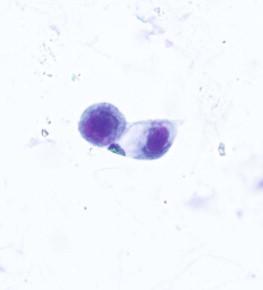
Ancillary tests are available to increase the sensitivity of biopsy. rt-PCR has variable success in increasing diagnostic yield of biopsy, depending on the study. Chromogenic in situ hybridization for CMV DNA and immunohistochemistry for CMV antigens has also been shown to increase sensitivity. Accordingly, the Transplantation Society recommends all biopsies for CMV in transplant patients be worked up with either CISH or immunohistochemical (IHC) studies to maximize the sensitivity of biopsy in this otherwise very serious disease.
Marked nucleomegaly and cytomegaly
Thick, irregularly marginated chromatin
Ovoid basophilic nuclear inclusions with halo
Eosinophilic cytoplasmic inclusions.
Esophagitis due to infection by HSV is the major entity in the differential diagnosis ( Table 14-1 ). It is important to recall that HSV infects squamous epithelial cells, whereas CMV involves both glandular and stromal elements. Multinucleation and pale homogeneous (ground-glass) chromatin are frequent in HSV infections, but are almost never seen with CMV. On the other hand, cytoplasmic inclusions occur only within CMV virocytes. In esophageal brushings, HSV virocytes are almost always present in much larger numbers than CMV virocytes. Furthermore, CMV virocytes are almost always individually dispersed, whereas herpes virocytes are often in small aggregates. To complicate matters even more, both viruses can infect the same patient simultaneously.
| Feature | HSV | CMV |
|---|---|---|
| Cell type infected | Squamous | Stromal, glandular |
| Multinucleation | + | − |
| Ground-glass chromatin | + | − |
| Cytoplasmic inclusions | − | + |
A smattering of other recognizable infectious agents may rarely cause esophagitis. Bacteria are rarely implicated as a cause of esophagitis. Case reports have included organisms such as Actinomyces , for example. In cytologic specimens, specific identification cannot be made. Bacteria are also seen in smears from individuals with esophagitis due to other causes. Whether these bacteria are simple contaminants or are contributing to the pathogenesis of disease is unknown. Therefore, reporting the presence of bacteria in an esophageal smear may be prudent. Candida aside, it is rare for other eukaryotic organisms to produce clinical esophagitis. For example, rare cases of esophageal aspergillosis in cytologic brushings have been reported in immunocompromised patients ( Fig. 14-5 ). Additionally, a rare case report of esophageal disease resulting from trichomoniasis in AIDS patients has also been published. Various viral agents, in addition to the more common HSV and CMV, have been reported including the human immunodeficiency virus and the human papilloma virus (HPV) as etiologic agents in esophagitis.
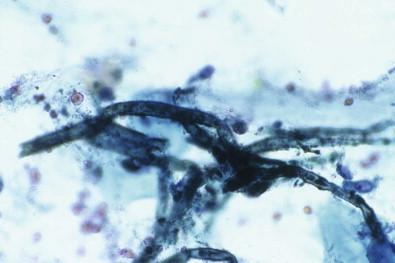
Not much has been written specifically on the cytopathology of treatment effect in the esophagus, likely because the most common method of diagnosis in this organ is endoscopically directed tissue biopsy. As a result, some extrapolation from histologic findings often has to be made when approaching esophageal cytology in patients who have undergone therapy for esophageal neoplasia. The non-surgical therapies for neoplasia currently come in three varieties: (1) ablative therapies for non-invasive lesions and (2) radiation therapy, (3) with or without concurrent chemotherapy.
Ablative therapies apply some form of energy as light (e.g., photodynamic therapy and argon plasma coagulation) or electrical energy (i.e., electrocoagulation) to destroy the superficial neoplastic cells found on endoscopy and biopsy of the esophagus. This treatment can restore normal, benign squamous epithelium to the superficial portions of the epithelium, while leaving metaplastic foci, called “buried Barrett's” in the submucosa, out of reach of cytologic sampling brushes. In this way, the main theoretical value of cytology in the setting of ablative therapies would be to monitor for superficial response.
The cytomorphologic features of radiation esophagitis include prominent but relatively proportionate nucleomegaly and cytomegaly with a retention of a relatively normal N : C ratio. Vacuolization of the nuclei and cytoplasm, irregularities in the nuclear membranes, and multinucleation are all features that may be seen in cytologic specimens ( Fig. 14-6 ). For the most part, chromatin is very finely granular or almost structureless and pale staining.
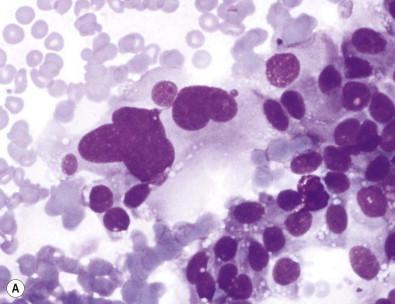
The superficial changes in the esophageal mucosa after radiation therapy are short-lived. In addition to the radiation atypia, the mucosa may demonstrate parakeratosis, mucosal thickening, or even ulceration. However, by 3–12 months' post-irradiation, the superficial changes completely regress into unremarkable squamous mucosa. The long-term changes are submucosal. These include hypertrophied, bizarre endothelial cells with homogenization of the surrounding collagen. The fibroblasts may show similar atypia, and the submucosal glands can have atrophy and squamous metaplasia in a background of fibrosis. However, all these changes are submucosal, completely out of the reach of luminal cytologic sampling techniques.
Chemotherapy-related changes may live a little more superficially. The best data currently available were reported an elegant study performed in 1983 by O'Morchoe and colleagues. It was a retrospective analysis of cytologic findings in esophagitis patients treated with radiation therapy, both with and without concurrent chemotherapy. Esophagitis patients without a history of malignancy were used as the control specimens. One very striking find from this classic study is that the cytologic changes associated with cytotoxic chemotherapeutic agents can be exactly the same as radiation changes. With one notable, memorable exception, there is no reproducible association between specific chemotherapeutic agents and specific morphologic findings. Taxanes are associated with a rather unique finding of ring mitoses that are typically found in the replicative compartment of the GI mucosa. Currently, no good data exist on the sensitivity of detecting taxane-related morphologic changes on gastrointestinal brush cytology.
Esophageal adenocarcinoma has a strong association with dysplasia arising in Barrett's metaplasia. Not long ago, esophageal adenocarcinoma was a rare entity, constituting only a minority of malignancies in the tubular esophagus. That has certainly changed such that now adenocarcinoma is the most common esophageal malignancy, outstripping the formerly most common squamous cell carcinoma. These neoplasms almost always present in the distal third of the esophagus and often appear to straddle the gastroesophageal junction. The most common clinical presentation is progressive dysphagia. Endoscopically, they appear as either large ulcers or fungating polypoid masses; the diameter of the lumen is often greatly reduced.
To Dr Norman Barrett in 1950s London, the entire concept of “peptic esophagitis” was a simple one: histologically, if there was a gastric-type columnar epithelium present in the anatomic esophagus, a patient had “peptic esophagitis,” a greatly debated concept at that time. Over half a century later, we still remember the name because it has the honor of being associated with an interesting modern controversy: what is Barrett's esophagus? Not as handsome a debate as to the meaning of “peptic esophagitis” faced by Dr Barrett at the beginning of the Cold War, but a modern pathologic disquisition all the same.
Currently, there is some debate as to the true pathologic definition of the disease process that now bears the name of the English physician. It is a question that has enormous potential impact on the management of patients with chronic gastroesophageal reflux disease. The international controversy centers on goblet cells. Goblet cells are the histologic hallmark of intestinal metaplasia. Intestinal metaplasia, in turn, is the sine qua non of Barrett's esophagus – or, is it? The American Gastroenterological Association insists on goblet cells, while the British counterpart (British Society of Gastroenterology) prefers a less discriminatory Barrett's esophagus, one in which “the presence of areas of intestinal metaplasia, although often present, is not a requirement for diagnosis.” Removing the requirement for intestinal metaplasia (i.e., goblet cells) from the diagnosis of Barrett's esophagus has enormous financial implications at a societal level and psychologic implications on the personal level as Barrett's esophagus is thought to be the major histologic precursor of adenocarcinoma of the esophagus. The classic study linking Barrett's esophagus to such an aggressive malignancy noted that “Barrett esophagus was found in 64% of the cases (39 of 61), but had been recognized in only 38% of the patients with Barrett-associated carcinoma who had undergone preoperative endoscopy with biopsy (13 of 34).”
Such expansionism has, of course, sparked debate among experts. Some workers feel that the risk of progression from esophageal columnar cell change to eventual esophageal adenocarcinoma is inevitable in a high enough proportion of patients with columnar-lined esophagus (CLE) to justify the inclusion of far more persons into screening programs currently under study. Other workers boldly assert that the finding of columnar cell change by itself “has no proven risk of adenocarcinoma,” precluding any justification for treating patients with CLE only, as though they were moving inexorably toward a death by esophageal cancer. The solution to this very difficult question is, of course, quite beyond this chapter on cytopathology, especially in light of the somewhat disappointing performance of most screening modalities available to both sides of the debate today. What all sides, it seems, agree on is that virtually all cases of intestinal metaplasia coexist with CLE in the esophagus. That, plus other epidemiologic arguments seem to indicate that CLE is a precursor lesion for intestinal metaplasia, which is the most commonly known precursor lesion for adenocarcinoma of the esophagus. Therefore, while the presence of CLE is of uncertain clinical significance, it would perhaps be best to inform the clinician of its presence when discovered on esophageal biopsy, whether histologic or cytologic. From there, the clinician might decide whether the British or the American way of doing things is more favorable for any given patient.
Just as CLE is not a guarantee to the development of intestinal metaplasia, similarly intestinal metaplasia (we will use this definition for Barrett's esophagus) does not guarantee the development of esophageal adenocarcinoma (EAC). Far from it, in fact, the risk of progression to EAC in patients with known intestinal metaplasia (with or without low-grade dysplasia) has been reported – in larger studies or meta-analyses – to be as high as 0.5% and as low as 0.12% per year in each patient diagnosed with intestinal metaplasia. There are even data in the literature to indicate that over 75% of esophageal and gastric cardia adenocarcinomas are not associated with Barrett's metaplasia (defined by the presence of columnar epithelium with goblet cells) at the time of diagnosis. In other words, the role of surveillance and screening for EAC is far from a settled issue, though outcomes are so poor in EAC that some authors make a strong argument for screening and surveillance measures, despite the low risk of progression from intestinal metaplasia (with or without low-grade dysplasia) to EAC.
Since progression to EAC is thought to begin with CLE, making a stop at intestinal metaplasia on its way to cancer, we will present our microscopic description in this order.
As its name implies, columnar cell change is the replacement of the normal squamous mucosa with banal, orderly mucosa comprising columnar cells, much like that seen in the superficial portions of gastric mucosa and the openings of the gastric pits. The cells have uniform, basally oriented nuclei with abundant neutral mucin sitting atop the nucleus and well-defined, straight (not bulging) intercellular borders ( Fig. 14-7 ). The mucin presents as finely granular or multivesicular material. Smears are dominated by large flat sheets of cohesive uniform-appearing glandular epithelial cells. The sheets and aggregates have sharp, smooth borders. That is, they do not appear frayed and irregular. This reflects the retention of a normal level of intercellular cohesion. Normal polarity is also maintained. Thus, within the sheets, the nuclei appear equidistant from one another, and intercellular borders are distinct. This creates the classic honeycomb appearance. In the presence of reparative atypia in benign Barrett's epithelium, there may be a streaming effect in which the cells and their nuclei all appear to flow in the same direction ( Fig. 14-8 ). Still, cohesion and polarity are maintained, in contrast to carcinomas of the esophagus (see Table 14-2 ).
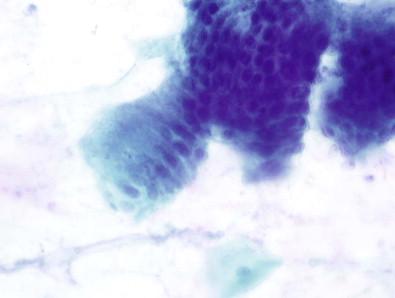
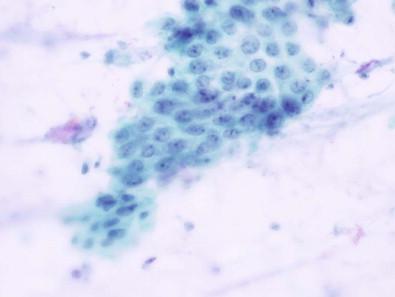
| Epithelial Repair | Adenocarcinoma |
|---|---|
| Groups of cells | Groups of cells |
| Rare single cells | Many intact single cells |
| Flat metaplastic sheets maintaining honeycomb | Syncytial arrangement pattern |
| Distinct cytoplasmic borders | Variable to indistinct cytoplasmic borders |
| Cellular polarity maintained | Loss of polarity |
| Enlarged nuclei | Enlarged nuclei |
| Round-to-oval nuclei with smooth nuclear borders | Irregular nuclear borders |
| Uniform nuclei | Variably sized nuclei (anisonucleosis) |
| Vesicular and hypochromatic to mildly hyperchromatic with even chromatin distribution | Opaque to hyperchromatic nuclei with irregular chromatin distribution and parachromatin clearing |
| Nucleoli may be prominent | Nucleoli often irregular in shape |
| Normal mitotic figures | Normal and abnormal mitotic figures |
| No diathesis unless ulcer is present | Clear background or tumor diathesis |
The addition of goblet cells to CLE is the cytologic and histologic definition of intestinal metaplasia. However, the presence of goblet cells may be difficult to detect on cytologic preparations. As a result, Geisinger and colleagues described cytologic intestinal metaplasia as large, flat sheets of columnar cells, without even mentioning goblet cells. Perhaps then, cytologically, the British definition of intestinal metaplasia may be more useful than earlier argued?
Though the goblet cells typically represent a minority population in the honeycomb sheets, they are readily visible because of their distinctive morphology, the metaplastic nuclei are uniform from cell to cell, having round or slightly ovoid contours, delicate smooth nuclear membranes, and very finely granular vesicular chromatin. In general, nucleoli are inconspicuous, but, in some cases of atypia, they may be quite enlarged. When viewed on end, the cardiac-type mucus cells have a hexagonal configuration, whereas the goblet cells have a more rounded, bulging contour ( Fig. 14-9 ). The latter appear as sharply punched-out clear areas. The smear background typically is clean, although a few inflammatory elements may be scattered about.
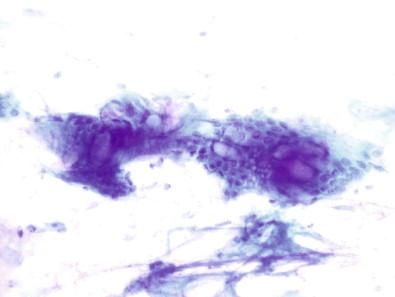
Dysplasia, especially the high-grade variety, is the most ominous preinvasive finding in esophageal cytology. Dysplastic Barrett's epithelium is the precursor to invasive adenocarcinoma and the dysplastic cells have some but not all the features of malignant cells. Dysplastic glandular epithelium in Barrett's esophagus is characterized by columnar-shaped cells having enlarged, oval to somewhat elongated hyperchromatic nuclei that are typically pseudostratified. The nuclei may have large nucleoli and increased N : C ratios. In low-grade dysplasia the nuclei remain concentrated in the basal portion of the cells with mild nuclear atypia and pleomorphism often in crowded groups with a degree of nuclear stratification ( Fig. 14-10A ). In high-grade dysplasia, many nuclei are oriented toward the glandular lumina with the higher degree of nuclear atypia and pleomorphism often found in crowded groups or occasionally with isolated cells ( Fig. 14-10B ). Dystrophic goblet cells with abnormally positioned and/or sized nuclei may be present.

The cytologic diagnosis of adenocarcinoma of the esophagus can be readily made. However, it is less widely recognized that one can render a diagnosis of glandular dysplasia in esophageal brushings. As might be expected, many of the cytologic criteria for dysplasia and adenocarcinoma are the same. In both, there is a reduction in the degree of intercellular cohesion, so that, in comparison to benign Barrett's epithelium, the smears contain smaller cellular aggregates with frayed irregular margins ( Figs 14-10 , 14-11 ). In addition, there are variable numbers of individually dispersed abnormal cells. In adenocarcinomas, these isolated malignant elements may be numerous, whereas individual abnormal cells are very sparse in brushings from patients with pure dysplasia ( Fig. 14-11 ). In both carcinoma and dysplasia, polarity is also reduced, so that within cellular aggregates there is a haphazard array of crowded and overlapped abnormal nuclei. Attendant with this is a reduction in obvious cellular borders with the formation of syncytia. Dysplastic aggregates may be somewhat larger than those typical of adenocarcinoma. Cytoplasmic mucin is greatly reduced. Cytoplasm remains more delicate than that typically seen in squamous cell carcinoma. Also evident are the nuclear changes generally ascribed to malignant cells. The nuclei are enlarged and variably pleomorphic; their shapes vary from round to ovoid to a characteristic elongated (cigar-shaped) appearance. The latter are especially common in both dysplasia and well-differentiated adenocarcinomas. The nuclear membranes are thick and slightly irregular in contour. Hyperchromasia is generally evident, as are large nucleoli that may be multiple and irregular in shape. In brushings from patients with adenocarcinoma, but not in those with only dysplasia, the smear background has a “dirty” appearance, reflecting a tumor diathesis secondary to invasion and necrosis ( Fig. 14-11 and Table 14-3 ). In summary, although dysplasia can be suggested, it may not be absolutely distinguished from a well-differentiated adenocarcinoma on cytologic grounds. Furthermore, dysplasia may not be accurately graded by cytologic examination; this requires a tissue biopsy for histologic correlation.
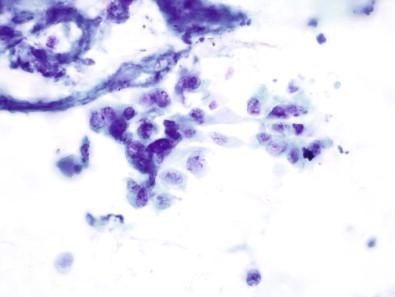
| Feature | Repair | Dysplasia | Adenocarcinoma (Intestinal Type) |
|---|---|---|---|
| Cellular aggregates | Large, smooth edges, normal polarity | Small, frayed edges, altered polarity | Small, frayed edges, altered polarity |
| Individual cells | Rare to absent | Few | Few to many |
| Nuclear contours | Smooth, round to oval | Slight irregularities, elongated | Slight to prominent irregularities |
| Chromatin | Pale | Hyperchromatic | Hyperchromatic |
| Nucleoli | Large, prominent, smooth | Large | Large, angulated |
| N : C ratio | Normal to slightly increased | Slightly to moderately increased | Slightly to greatly increased |
| Background | Clean | Clean | Diathesis |
Reduced intercellular cohesion: small cellular aggregates with frayed borders, individually dispersed abnormal cells
Loss of polarity with irregular distribution of crowded, overlapped nuclei
Indistinct cell borders
Nuclei: thickened membranes with contour irregularities, pleomorphism, hyperchromasia, large nucleoli; nuclei tend to be rounder in carcinoma than in dysplasia
Greater degrees of changes in carcinoma than in dysplasia, including increased numbers of single abnormal cells.
In cases where morphology leaves some disquiet, immunohistochemistry may be considered. Esophageal adenocarcinomas typically express cytokeratin (CK)7 with variable expression of CK20. CDX2, a marker of gastrointestinal differentiation, is positive in only about half of EACs. No marker has been described that is specific for EAC.
In recent years, esophageal brush cytology has decreased in favor among clinicians. In our own institution, esophageal brushings are not very common in the cytology service, in contrast to the average of eight per week in the 1980s. This is not a trend unique to our institution. As discussed above, esophageal cytology, on its own, performs rather poorly as a screening modality for esophageal adenocarcinoma. A recent study indicated a sensitivity as low as 5% for endoscopically directed brush cytology alone. So, why then even bother?
First, there are good data to indicate that cytology with biopsy is complementary. As a standalone test for screening in high-risk patients, cytology does seem to have limited utility. However, it can improve the yield of endoscopically directed tissue biopsy. This is especially promising, considering that the current gold standard for monitoring Barrett's esophagus for dysplasia consists in four-quadrant biopsies taken every centimeter of endoscopically abnormal mucosa, leading to a large number of biopsies needed per patient. Perhaps, with continued development of combination modality techniques, the need for high numbers of tissue biopsies will decrease and the utility of esophageal brushings will increase, leading to an overall reduction of expense in the monitoring of Barrett's esophagus. The complementarity between tissue biopsy and esophageal brushing is further emphasized by noting that cytology has been shown to have very good success in detecting high-grade lesions, with limited success in detecting low-grade lesions; a situation very similar to urine cytology in screening for urothelial lesions.
Second, improvements in endoscopic esophageal imaging may lead to better outcomes by allowing endoscopists greater ability to direct cytologic brushes, improving the yield of cytology even further. “Advanced endoscopic imaging technologies, such as narrow band imaging (NBI), autofluorescence imaging (AFI), and confocal laser endomicroscopy (CLE), may improve the accuracy in the detection of dysplasia and early cancer, increasing the effectiveness of endoscopic surveillance.” Of course, discussion of any of these quite technical endoscopic modalities is beyond the scope of a cytopathology textbook.
Finally, cytologic sampling of the esophagus may experience recrudescence as molecular techniques are developed. For example, it is known that p16 mutation can influence outcome and prognosis in endoscopic interventions. And, p16 aberrancies are seen in nearly half of specimens with intestinal metaplasia. Making use of growing knowledge of the molecular pathology of disease, scattered laboratories offer a fluorescence in situ hybridization (FISH) panel to aid in the diagnosis of high-grade dysplasia. The panel utilizes a probe set that consists of directly labeled DNA probes to 8q24 ( C-MYC ), 9p21 ( P16 ), 17q12 ( HER2 ), and 20q13. An early study out of the Mayo Clinic indicated that this panel had excellent sensitivity for EAC (100%), moderate sensitivity for high-grade dysplasia (82%), and poor sensitivity for low-grade dysplasia (50%). This study utilized four-quadrant tissue biopsy as the gold standard, indicating that biopsy is still a more sensitive test than molecular methods, especially for low-grade lesions. Although the Mayo Clinic and other laboratories offer this panel for clinical use, its utility is in high-grade lesions (Halling KC, 2013, personal communication).
Many excellent reviews have been published on the risk factors of esophageal squamous cell carcinoma (ESQC). The most important, modifiable risk factors in the development of esophageal squamous dysplasia and subsequent squamous cell carcinoma is alcohol intake and tobacco use. Alcohol abuse is the primary risk factor, with a synergistic effect exerted by concurrent smoking. The two together raise the risk of ESQC to 50 times greater than that of the non-smokers and non-drinkers. It is a curious and interesting discovery that the presence of difficulty in metabolizing alcohol (in patients with acetaldehyde dehydrogenase 2 deficiency) leads to an even higher risk of ESQC in the presence of alcohol overuse. Other risk factors may have to do with vitamin deficiencies and diets high in nitrosamines. A familial history of cancer is also known to increase the risk of this malignancy. A study from Latin America has recently been published, which, through multivariate analysis, has found a contribution from atrophic gastritis to the increased risk of ESQC.
HPV, however, has not been clearly associated with ESQC. This is important to note since many head and neck squamous lesions have an association with HPV.
Although most common in the middle of the esophagus, squamous cell carcinoma may arise at any site along the entire length of the organ. Endoscopically, they present as large fungating polyploid masses, deep irregular ulcers, or flat mucosal elevations. Frequently, the luminal caliber is markedly reduced; the stenosis may be so tight that biopsy forceps may not be able to reach the neoplasm adequately.
Histologically, squamous cell carcinoma can be divided into three grades, with the well-differentiated neoplasms most closely resembling normal squamous epithelium. The presence of voluminous cytoplasm, well-developed keratinization, and distinct intercellular bridges correlates with better differentiated neoplasms. In the well-differentiated carcinomas, many of the nuclei have a dense pyknotic-like chromatin pattern. In the more poorly differentiated squamous carcinomas, the chromatin is more finely granular with areas of chromatin clearing. Furthermore, large prominent nucleoli tend to occur in the more poorly differentiated malignancies. Overall, N : C ratios are much higher in the high-grade carcinomas. As in the uterine cervix, when carcinoma does not invade into the underlying lamina propria, the diagnosis of carcinoma in situ is made.
The cytologic picture in brushings from patients with squamous cell carcinoma reflects the underlying histologic grade. In well-differentiated carcinomas, intercellular cohesion is relatively well maintained. Accordingly, smears contain sizeable aggregates of large tumor cells that have abundant dense-appearing cytoplasm ( Fig. 14-12 ). With the Papanicolaou reaction, many of the neoplastic cells may have orangeophilic cytoplasm. Typically, their nuclei are centrally positioned and have sharply angulated contours. The chromatin is characteristically very hyperchromatic and coarsely granular or almost pyknotic in quality. Keratin pearls, elongated cellular configurations (tadpole cells), and numerous anucleated squames may be present as well. In the less differentiated squamous cell carcinomas, the smears typically contain smaller cellular aggregates and often numerous individually dispersed neoplastic cells, reflecting reduced cohesion. Cytoplasm remains dense but is much more frequently cyanophilic. Lower volumes of cytoplasm translate into higher N : C ratios ( Fig. 14-13 ). Pyknotic chromatin is less frequent as well; rather, the chromatin appears finely to coarsely granular. Nucleoli are also more apparent.
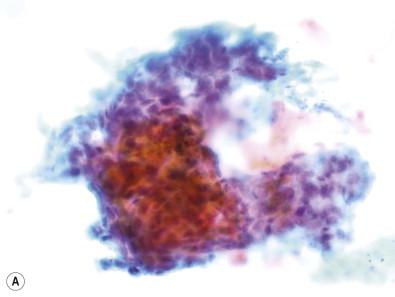
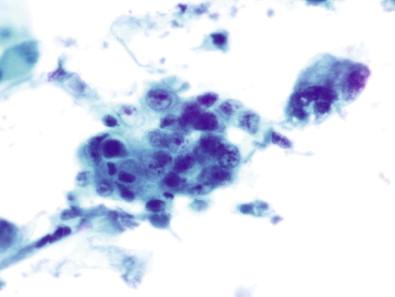
Variability in cellular size and shape
Optically opaque cytoplasm, varying from orangeophilic to cyanophilic; well-defined cell borders
Centrally positioned angulated nuclei
Obviously hyperchromatic chromatin, typically coarsely granular to structureless
Variable nucleoli
Variable intercellular cohesion.
Poorly differentiated ESQC may pose morphologic difficulties. In cases such as this, immunohistochemistry may be very helpful. Squamous cell carcinoma tends to be negative for both CK7 and CK20, in contrast to esophageal adenocarcinomas, which are often positive for CK7 with variable expression of CK20. Typically, ESQCs have cytoplasmic reactivity with makers for the high-molecular weight cytokeratins 34βE12 (also call CK903) and CK5/6 with nuclear expression of p63.
Studies into the molecular pathology of esophageal squamous cell carcinoma is perhaps even less promising today than the discoveries made in adenocarcinomas of the esophagus. As mentioned above, p63 is regulatory protein, the gene for which is found to be diseased in nearly half of EAC and its precursors. The squamous counterpart to this is p16INK4a (encoded by the CDKN2A gene), which is a cell cycle regulatory protein. However, derangements of this gene are found in less than 40% of ESQC precursors, limiting its utility as a screening test for squamous-type malignancy. TP53 abnormalities are most common, but not very specific.
The prognosis of esophageal small-cell carcinoma (ESmCC) is abysmal – only about 25% survival rate at 5 years, similar to that of esophageal squamous cell carcinoma. The most common presenting symptom is rapidly progressing dysphagia, often portending a very advanced tumor with few options for successful treatment. As with small-cell carcinoma of the lung, ESmCC has a strong association with tobacco use, with some authors reporting a 90% tobacco exposure rate in patients with ESmCC. Alcohol use has a similar epidemiologic association with this aggressive malignancy. The quintessential patient is a gentleman in his sixties, with a smoking history, who presents with rapidly progressing dysphagia with chest or back pain, and who succumbs to his disease far too soon after presentation. However, as with any malignancy, clinicoepidemiologic tunnel vision can prove to be a maladaptive trait for physicians as small-cell carcinoma has also been reported as arising in Barrett's esophagus.
Anatomically, the location of this tumor varies depending on the demographic of the patient in whom it presents. Small-cell carcinoma has the uncanny propensity to present in different areas of the tubular esophagus depending on the patient population studied. For example, in the USA, ESmCC seems to have an affinity for the distal esophagus. In other parts of the world, such as China, Europe, and Japan, the same malignancy – ostensibly the same, at least – prefers to avoid gastric acidity, growing more commonly in the mid-esophagus.
This section, as well as the one below on immunophenotype, requires a caveat. There is very little recent material on the cytologic and immunophenotypic diagnoses of primary esophageal small-cell carcinoma. Often, authors have relied on the more robust literature on pulmonary small-cell carcinomas, extrapolating that data to ESmCC. Where necessary, we have done the same here.
The appearance of this malignancy through a microscope is just as ugly as its clinical behavior. The smears are typically hypercellular, leading to a characteristic “1×” appearance on Diff-Quik stains of a solid sheet of purple, almost allowing for a diagnosis by examining the slide with the naked eye. Microscopic examination, when performed on patient material with this diagnosis, reveals innumerable malignant cells, sometimes extending “wall-to-wall” on the cytologic slides. At other times, when the sampling is less ample, the cellularity may be far less impressive. The malignant cells form loosely cohesive groups that readily fall apart into single cells. Cytologically, the cells are relatively small, as the name implies: only two to three times the size of a quiescent lymphocyte. However, morphometric studies have demonstrated that the cells constituting high-grade neuroendocrine tumors exist along a spectrum of sizes from those that are obviously small cell all the way up in size to those that form a large-cell carcinoma. Other characteristic features are scanty cytoplasm that may occasionally contain perinuclear blue bodies. Nuclear molding is thought to be a characteristic, if sometimes inconsistent, feature of this malignancy: the nuclei appear to be so compressed into each other that they deform (i.e., mold) one another's shapes into awkward geometric polygons. Crush artifact may also be seen. Nuclear features are an important diagnostic feature: the nuclei should have powdery, stippled chromatin. They are not supposed to harbor nucleoli. While there will always be the stubborn non-conformist, the diagnosis of small-cell carcinoma should be made with great caution in a malignancy with obvious nucleoli.
Histologically, there are many twists and turns in the growth pattern of small-cell carcinoma that may be mirrored in cytologic specimens. Architecturally, rosettes and trabeculae may be present on histology; likewise, such features may be recapitulated on cytologic preparations. Anaplasia and spindle cell cytology is also seen in esophageal small-cell carcinoma. Another potential source is the concomitance of ESmCC with areas of malignancy that lack neuroendocrine differentiation. Up to 8% of ESmCCs are thought to have both neuroendocrine and non-neuroendocrine (i.e., squamous cell carcinoma or adenocarcinoma differentiation) components.
Since the cytomorphology of small-cell carcinoma is seemingly so unique, why should we think more about the need for immunohistochemical markers are molecular pathology? To confirm the importance of ancillary studies in cytologic preparations of the esophagus, we are forced to turn to the literature on pulmonary cytopathology, since the published data for ESmCC is rather sparse. Extrapolating from one organ and one biopsy modality (fine-needle aspiration (FNA) in lung) to another organ with another biopsy technique (brushing in the esophagus) is fraught with potential for misapplication of results. However, the scarcity of research on ESmCC leaves us no option but to try to make this extrapolation. Specifically, a fascinating study by Renshaw and colleagues in 2005 on pulmonary small-cell carcinoma demonstrated that cytopathologists can misclassify a small-cell carcinoma of the lung as a non-small-cell carcinoma of the lung in a significant proportion of cases. Likely, the same would be true for ESmCC if the numbers of cases were available to conduct an adequately powered study looking for the same discordance in diagnosis.
Immunohistochemistry can be of great help as an aid in making the diagnosis of small-cell carcinoma. The typical panel that is utilized in our laboratory consists of some combination of a pancytokeratin marker (we use AE1/AE3) with neuroendocrine markers (synaptophysin, chromogranin, and CD56). Again, borrowing from the pulmonary small-cell carcinoma literature, these immunostains should be interpreted with caution, as up to two-thirds of small-cell carcinomas may be negative for synaptophysin and chromogranin. CD56 seems to be much more reliably expressed, nearly 100% in some series.
The immunophenotype of other esophageal malignancies has been discussed above. However, two words of caution are in order, one about thyroid transcription factor-1 (TTF-1) and the other about p63. TTF-1 is used in the diagnosis of pulmonary adenocarcinomas with great frequency. Yet, this stain cannot be used to determine the organ of origin of a neuroendocrine carcinoma because most small-cell carcinomas (both pulmonary and extrapulmonary) are known to have nuclear expression of TTF-1. The expression of p63 protein can also be deceptive. Since p63 is associated with basaloid (and, by extension, squamous) differentiation, it may be tempting to label a p63-positive esophageal malignancy as a squamous cell carcinoma. However, up to half of small-cell carcinomas have nuclear positivity for p63. This finding has led to the interesting theory that both squamous cell carcinoma and small-cell carcinoma may have similar histogenesis.
Molecular testing has not yet developed in this malignancy; no consistent molecular derangements are yet described. Furthermore, unlike with anorectal small-cell carcinoma, high-risk HPV types 16 and 18 have not been detected in esophageal small-cell carcinomas.
Become a Clinical Tree membership for Full access and enjoy Unlimited articles
If you are a member. Log in here